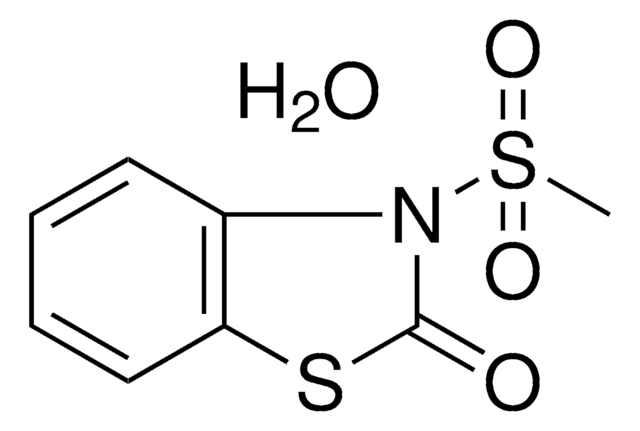NS1226
Cysteine Sulfenic Acid Probe (DCP-Bio1)
Wybierz wielkość
722,00 zł
Przewidywany termin wysyłki11 marca 2025Szczegóły
Wybierz wielkość
About This Item
722,00 zł
Przewidywany termin wysyłki11 marca 2025Szczegóły
Polecane produkty
Poziom jakości
Opis ogólny
The most commonly used method for assessing whether proteins are modified to contain cysteine sulfenic acid employs derivitization with 5,5-dimethyl-1,3-cyclohexanedione (dimedone), and subsequent detection with an antibody against dimedone-modified proteins. However, new reagents have been developed to simplify the analysis and isolation of proteins bearing cysteine sulfenic acid. DCP-Bio1, which consists of the sulfenic acid-reactive 3-(2,4-dioxocyclohexyl) propyl (DCP) appended to biotin, is a useful reagent for characterizing cellular cysteine sulfenic acid.
Zastosowanie
Solutions:
DCP-Bio1 stock solution
Resuspend entire contents of vial in 10 µL DMSO for a final concentration of 250 mM
Stock lysis buffer
50 mM Tris-HCl, pH 7.5
100 mM Sodium Chloride
0.1% SDS
0.5% Sodium Deoxycholate
0.5% NP-40
0.5% Triton X-100
Working lysis buffer
On the day of the assay, supplement stock lysis buffer with:
50 mM Sodium Fluoride
1 mM PMSF
1 mM DCP-Bio1
100 µM DTPA (Diethylene triamine pentaacetic acid)
10 mM N-ethylmaleimide
10 mM iodoacetamide
200 U/mL catalase
1x protease inhibitor cocktail
Cell treatment and lysis:
1)Seed adherent cells in 100 mm cell culture dishes, or other plate as desired.
2)Change to fresh growth media 30 minutes before selected treatments.
3)Wash all plates 2 times with 10 mL 1x PBS.
4)Add 150 µL working lysis buffer to plates and scrape cells.
5)Incubate lysates on ice for 1-2 hours.
6)Centrifuge lysates at 10,000 rpm for 10 minutes and collect supernatant.
7)Remove un-reacted DCP-Bio1 and other small molecules using Bio-Rad P6-Spin Columns (PN: 732-6227) following manufacturer′s instructions.
8)Measure protein concentration.
9)Perform biochemical analysis of interest.
DCP-Bio1 stock solution
Resuspend entire contents of vial in 10 µL DMSO for a final concentration of 250 mM
Stock lysis buffer
50 mM Tris-HCl, pH 7.5
100 mM Sodium Chloride
0.1% SDS
0.5% Sodium Deoxycholate
0.5% NP-40
0.5% Triton X-100
Working lysis buffer
On the day of the assay, supplement stock lysis buffer with:
50 mM Sodium Fluoride
1 mM PMSF
1 mM DCP-Bio1
100 µM DTPA (Diethylene triamine pentaacetic acid)
10 mM N-ethylmaleimide
10 mM iodoacetamide
200 U/mL catalase
1x protease inhibitor cocktail
Cell treatment and lysis:
1)Seed adherent cells in 100 mm cell culture dishes, or other plate as desired.
2)Change to fresh growth media 30 minutes before selected treatments.
3)Wash all plates 2 times with 10 mL 1x PBS.
4)Add 150 µL working lysis buffer to plates and scrape cells.
5)Incubate lysates on ice for 1-2 hours.
6)Centrifuge lysates at 10,000 rpm for 10 minutes and collect supernatant.
7)Remove un-reacted DCP-Bio1 and other small molecules using Bio-Rad P6-Spin Columns (PN: 732-6227) following manufacturer′s instructions.
8)Measure protein concentration.
9)Perform biochemical analysis of interest.
Komponenty
Jakość
Przechowywanie i stabilność
Oświadczenie o zrzeczeniu się odpowiedzialności
Kod klasy składowania
11 - Combustible Solids
Klasa zagrożenia wodnego (WGK)
WGK 3
Temperatura zapłonu (°F)
Not applicable
Temperatura zapłonu (°C)
Not applicable
Certyfikaty analizy (CoA)
Poszukaj Certyfikaty analizy (CoA), wpisując numer partii/serii produktów. Numery serii i partii można znaleźć na etykiecie produktu po słowach „seria” lub „partia”.
Masz już ten produkt?
Dokumenty związane z niedawno zakupionymi produktami zostały zamieszczone w Bibliotece dokumentów.
Nasz zespół naukowców ma doświadczenie we wszystkich obszarach badań, w tym w naukach przyrodniczych, materiałoznawstwie, syntezie chemicznej, chromatografii, analityce i wielu innych dziedzinach.
Skontaktuj się z zespołem ds. pomocy technicznej





